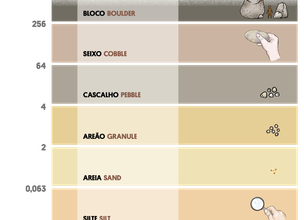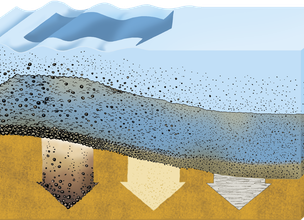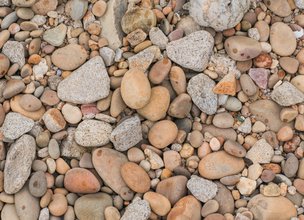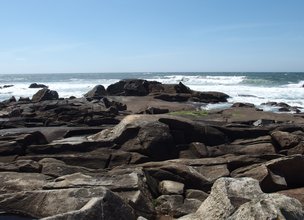Coastal landforms with sea-level changes
The coast is constantly changing! In this Local Natural Monument (LNM), rocks and sediments record natural changes in climate and sea level.
Sediments that are transported to the sea by rivers and afterwards by ocean currents along the coast, accumulating in beaches.
The size of sediments (fine or coarse sand, pebbles) (Left A) basically depends on the greater or lesser resistance of the minerals that constitute them, and on the intensity of the transport phase. Sediments originating from resistant minerals are usually bigger because they are more difficult to break up; on the other hand, longer transportation give rise to smaller sediments.
Therefore, it is possible to find in beaches sediments with different natures, grain sizes and origins. In this LNM, sediments are heterogeneous and some of them come from rocks that cannot be found nearby, such as quartzites (Fig. 1).
Sheltered beaches are more likely to accumulate sand. Over time, and with the natural variation of weather conditions, the sediments on a beach can alternate between sand and pebbles. Larger sediments remain near the coast where seawater agitation is more intense. Smaller sediments are transported and deposited at greater depths where conditions are calmer (Esq. B).
Coastal platforms and variation of sea level
Coastal platforms are surfaces flattened by the action of waves in the ocean-continent interface. These platforms are usually covered by beach sediments. However, sometimes local conditions do not favor sedimentation and rocky flattened surfaces became quite evident. In some coastal areas of this LNM, the erosion of the current platform is clear at present sea level (Fig. 2).
Near the coastline, it is possible to find other platforms above and below the current one. They are the testimony of times when sea levels were higher and lower than today. Platforms that developed during the Quaternary are particularly significant because during this geological period wide variations in sea levels occurred. These platforms are called marine or coastal terraces, being, in general, a support for beach deposits (sedimentary terraces) but also may not have a sedimentary cover (rocky terraces). In the Portuguese coastline, Quaternary terraces usually develop between current sea level (0 m) and 75m of altitude and are related to times when the sea level was higher. Nevertheless, there are several factors that might influence the position of coastal platforms, such as tectonics, which was particularly significant in Portugal.
References:
Pereira, P; Henriques, R.; Brilha, J. & Pereira, D.I. (2019). Conteúdos científicos para a caracterização dos 8 monumentos naturais locais” enquadrado no projeto Geoparque Litoral de Viana do Castelo – 2ª fase. Município de Viana do Castelo, Relatório Final GEOSITE, 273 p.
The coast is constantly changing! In this Local Natural Monument (LNM), rocks and sediments record natural changes in climate and sea level.
Sediments that are transported to the sea by rivers and afterwards by ocean currents along the coast, accumulating in beaches.
The size of sediments (fine or coarse sand, pebbles) (Left A) basically depends on the greater or lesser resistance of the minerals that constitute them, and on the intensity of the transport phase. Sediments originating from resistant minerals are usually bigger because they are more difficult to break up; on the other hand, longer transportation give rise to smaller sediments.
Therefore, it is possible to find in beaches sediments with different natures, grain sizes and origins. In this LNM, sediments are heterogeneous and some of them come from rocks that cannot be found nearby, such as quartzites (Fig. 1).
Sheltered beaches are more likely to accumulate sand. Over time, and with the natural variation of weather conditions, the sediments on a beach can alternate between sand and pebbles. Larger sediments remain near the coast where seawater agitation is more intense. Smaller sediments are transported and deposited at greater depths where conditions are calmer (Esq. B).
Coastal platforms and variation of sea level
Coastal platforms are surfaces flattened by the action of waves in the ocean-continent interface. These platforms are usually covered by beach sediments. However, sometimes local conditions do not favor sedimentation and rocky flattened surfaces became quite evident. In some coastal areas of this LNM, the erosion of the current platform is clear at present sea level (Fig. 2).
Near the coastline, it is possible to find other platforms above and below the current one. They are the testimony of times when sea levels were higher and lower than today. Platforms that developed during the Quaternary are particularly significant because during this geological period wide variations in sea levels occurred. These platforms are called marine or coastal terraces, being, in general, a support for beach deposits (sedimentary terraces) but also may not have a sedimentary cover (rocky terraces). In the Portuguese coastline, Quaternary terraces usually develop between current sea level (0 m) and 75m of altitude and are related to times when the sea level was higher. Nevertheless, there are several factors that might influence the position of coastal platforms, such as tectonics, which was particularly significant in Portugal.
References:
Pereira, P; Henriques, R.; Brilha, J. & Pereira, D.I. (2019). Conteúdos científicos para a caracterização dos 8 monumentos naturais locais” enquadrado no projeto Geoparque Litoral de Viana do Castelo – 2ª fase. Município de Viana do Castelo, Relatório Final GEOSITE, 273 p.

Esq. A - Sediments name according to their grain size.

Esq. B - Transport of sediments and sedimentation near the coast.
Location
Afife
Coordinates
Lat: 41.7958195
Long: -8.8738351
Hello little one!
I'm Piquinhos and I can help you learn more about the Geopark!
Technical details
Esq. A - Sediments name according to their grain size.
Esq. B - Transport of sediments and sedimentation near the coast.
Child Mode
Discover the geopark in a simpler format, aimed at the little ones.
Clique ENTER para pesquisar ou ESC para sair

